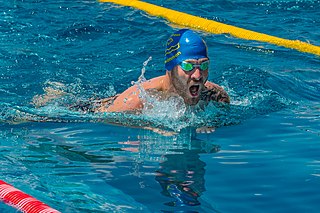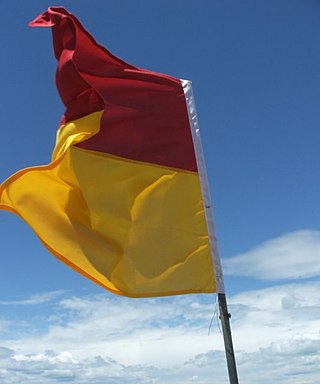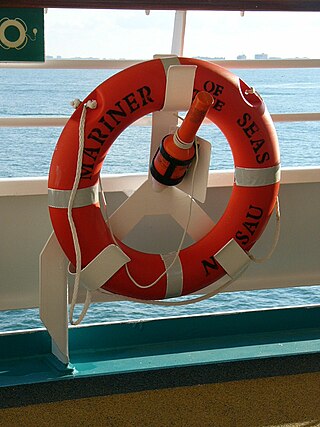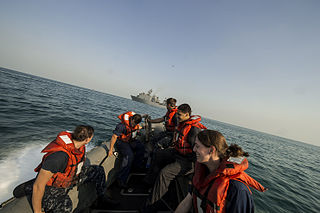
Swimming is the self-propulsion of a person through water, or other liquid, usually for recreation, sport, exercise, or survival. Locomotion is achieved through coordinated movement of the limbs and the body to achieve hydrodynamic thrust that results in directional motion. Humans can hold their breath underwater and undertake rudimentary locomotive swimming within weeks of birth, as a survival response.
Treading water or water treading is what a swimmer can do while in a vertical position to keep their head above the surface of the water, while not providing sufficient directional thrust to overcome inertia and propel the swimmer in any specific direction. As it expends less energy than traditional strokes, it is often used by swimmers to rest in between periods of exertion without having to leave the water.

Drowning is a type of suffocation induced by the submersion of the mouth and nose in a liquid. Most instances of fatal drowning occur alone or in situations where others present are either unaware of the victim's situation or unable to offer assistance. After successful resuscitation, drowning victims may experience breathing problems, vomiting, confusion, or unconsciousness. Occasionally, victims may not begin experiencing these symptoms until several hours after they are rescued. An incident of drowning can also cause further complications for victims due to low body temperature, aspiration of vomit, or acute respiratory distress syndrome.

A rip current is a specific type of water current that can occur near beaches where waves break. A rip is a strong, localized, and narrow current of water that moves directly away from the shore by cutting through the lines of breaking waves, like a river flowing out to sea. The force of the current in a rip is strongest and fastest next to the surface of the water.

A lifeguard is a rescuer who supervises the safety and rescue of swimmers, surfers, and other water sports participants such as in a swimming pool, water park, beach, spa, river and lake. Lifeguards are trained in swimming and CPR/AED first aid, certified in water rescue using a variety of aids and equipment depending on requirements of their particular venue. In some areas, lifeguards are part of the emergency services system to incidents and in some communities, lifeguards may function as the primary EMS provider.

Breaststroke is a swimming style in which the swimmer is on their chest and the torso does not rotate. It is the most popular recreational style due to the swimmer's head being out of the water a large portion of the time, and that it can be swum comfortably at slow speeds. In most swimming classes, beginners learn either the breaststroke or the freestyle first. However, at the competitive level, swimming breaststroke at speed requires endurance and strength comparable to other strokes. Some people refer to breaststroke as the "frog" stroke, as the arms and legs move somewhat like a frog swimming in the water. The stroke itself is the slowest of any competitive strokes and is thought to be the oldest of all swimming strokes.
Human swimming typically consists of repeating a specific body motion or swimming stroke to propel the body forward. There are many kinds of strokes, each defining a different swimming style or crawl.

A lifebuoy is a life-saving buoy designed to be thrown to a person in water to provide buoyancy and prevent drowning. Some modern lifebuoys are fitted with one or more seawater-activated lights to aid rescue at night.

The Wasserwacht is a German lifeguard service. It is one of the five voluntary societies of the German Red Cross. The Wasserwacht is a non-profit organization made up of on volunteers.
Francesco "Frank" Pia is an American lifeguard, recognized in the field for his research and training on ways to rescue people in trouble in the water. He is best known for:

A personal flotation device is a flotation device in the form of a vest or suit that is worn by a user to prevent the wearer from drowning in a body of water. The device will keep the wearer afloat with their head and mouth above the surface – they do not have to swim or tread water in order to stay afloat and can even be unconscious.

Huntington State Beach is a protected beach in Southern California, located in the City of Huntington Beach in Orange County. It extends 2 miles (3.2 km) from Newport Beach north to Beach Boulevard, where the Huntington City Beach begins. The 121-acre (49 ha) park was established in 1942.
Action Park was an amusement and water park located in Vernon Township, New Jersey, United States, on the grounds of the Vernon Valley/Great Gorge ski resort. The park consisted primarily of water-based attractions and originally opened to the public in 1978, under the ownership of Great American Recreation (GAR).
Freediving blackout, breath-hold blackout, or apnea blackout is a class of hypoxic blackout, a loss of consciousness caused by cerebral hypoxia towards the end of a breath-hold dive, when the swimmer does not necessarily experience an urgent need to breathe and has no other obvious medical condition that might have caused it. It can be provoked by hyperventilating just before a dive, or as a consequence of the pressure reduction on ascent, or a combination of these. Victims are often established practitioners of breath-hold diving, are fit, strong swimmers and have not experienced problems before. Blackout may also be referred to as a syncope or fainting.

Swimming lessons are the process of learning to swim. In most countries there is a definition of a number of swimming levels that are reached in the process of the curriculum. The respective certificates of swimming tests are required for further training in aquatic abilities. Many countries have defined a minimum swimming level that children should reach by the end of primary education, in most cases with the help of school swimming classes being part of the normal curriculum.
National Water Life Saving Association (NWLSA), also known as Chinese Taipei Water Life Saving Association (CTWLSA), is the major lifesaving organization in Taiwan. The organization's members are mainly volunteer lifesavers, police officers, firefighters and civilians who are enthusiastic about water sports, water safety awareness and water rescue events.

The German rescue swimming badge is awarded by the Wasserwacht of the German Red Cross, the DLRG and the ASB for proficiency in rescue swimming skills. The German rescue swimming badge is awarded in bronze, silver, and in gold. The awards is available as a cloth patch, as a metal badge, or as a ribbon. The rescue swimming badges in silver and gold are permitted to be worn on uniforms of the Bundeswehr, the German Police and various rescue services as a ribbon. It is also an entry-requirement for some German Police agencies.
Water safety refers to the procedures, precautions and policies associated with safety in, on, and around bodies of water, where there is a risk of injury or drowning. It has applications in several occupations, sports and recreational activities.
The International Surf Lifesaving Association (ISLA) is a nonprofit organization that advances professional lifesaving development to areas in need around the globe. ISLA uses latest technology to identify areas in need. ISLA advances development through lifeguard training programs and aquatic rescue operation consults, lifeguard exchanges, equipment donations, and by integrating with drowning prevention organizations to share information, techniques, stories, and culture.
SV Nominoé was a French sailing ship that ran aground near Blankenberge, Belgium during a violent storm while she was travelling from London, United Kingdom to Swansea, Wales, United Kingdom with a cargo of asphalt.












